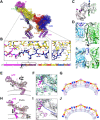The structure of an infectious immature flavivirus redefines viral architecture and maturation
- PMID: 33990320
- PMCID: PMC8121421
- DOI: 10.1126/sciadv.abe4507
The structure of an infectious immature flavivirus redefines viral architecture and maturation
Abstract
Flaviviruses are the cause of severe human diseases transmitted by mosquitoes and ticks. These viruses use a potent fusion machinery to enter target cells that needs to be restrained during viral assembly and egress. A molecular chaperone, premembrane (prM) maintains the virus particles in an immature, fusion-incompetent state until they exit the cell. Taking advantage of an insect virus that produces particles that are both immature and infectious, we determined the structure of the first immature flavivirus with a complete spike by cryo-electron microscopy. Unexpectedly, the prM chaperone forms a supporting pillar that maintains the immature spike in an asymmetric and upright state, primed for large rearrangements upon acidification. The collapse of the spike along a path defined by the prM chaperone is required, and its inhibition by a multivalent immunoglobulin M blocks infection. The revised architecture and collapse model are likely to be conserved across flaviviruses.
Copyright © 2021 The Authors, some rights reserved; exclusive licensee American Association for the Advancement of Science. No claim to original U.S. Government Works. Distributed under a Creative Commons Attribution NonCommercial License 4.0 (CC BY-NC).
Figures







Similar articles
-
A fusion-loop antibody enhances the infectious properties of immature flavivirus particles.J Virol. 2011 Nov;85(22):11800-8. doi: 10.1128/JVI.05237-11. Epub 2011 Aug 31. J Virol. 2011. PMID: 21880758 Free PMC article.
-
The flavivirus precursor membrane-envelope protein complex: structure and maturation.Science. 2008 Mar 28;319(5871):1830-4. doi: 10.1126/science.1153263. Science. 2008. PMID: 18369147
-
Maturation of flaviviruses starts from one or more icosahedrally independent nucleation centres.EMBO Rep. 2011 Jun;12(6):602-6. doi: 10.1038/embor.2011.75. Epub 2011 May 13. EMBO Rep. 2011. PMID: 21566648 Free PMC article.
-
Chaperone fusion proteins aid entropy-driven maturation of class II viral fusion proteins.Trends Microbiol. 2014 Feb;22(2):100-6. doi: 10.1016/j.tim.2013.11.006. Epub 2013 Dec 28. Trends Microbiol. 2014. PMID: 24380727 Free PMC article. Review.
-
Post-translational regulation and modifications of flavivirus structural proteins.J Gen Virol. 2015 Jul;96(Pt 7):1551-69. doi: 10.1099/vir.0.000097. Epub 2015 Feb 23. J Gen Virol. 2015. PMID: 25711963 Review.
Cited by
-
Irreversible furin cleavage site exposure renders immature tick-borne flaviviruses fully infectious.Nat Commun. 2025 Aug 12;16(1):7491. doi: 10.1038/s41467-025-62750-6. Nat Commun. 2025. PMID: 40796726 Free PMC article.
-
An Absolutely Conserved Tryptophan in the Stem of the Envelope Protein E of Flaviviruses Is Essential for the Formation of Stable Particles.Viruses. 2021 Aug 30;13(9):1727. doi: 10.3390/v13091727. Viruses. 2021. PMID: 34578308 Free PMC article.
-
Identification of a critical role for ZIKV capsid α3 in virus assembly and its genetic interaction with M protein.PLoS Negl Trop Dis. 2024 Jan 2;18(1):e0011873. doi: 10.1371/journal.pntd.0011873. eCollection 2024 Jan. PLoS Negl Trop Dis. 2024. PMID: 38166143 Free PMC article.
-
A chimeric vaccine derived from Australian genotype IV Japanese encephalitis virus protects mice from lethal challenge.NPJ Vaccines. 2024 Jul 31;9(1):134. doi: 10.1038/s41541-024-00903-2. NPJ Vaccines. 2024. PMID: 39085247 Free PMC article.
-
Replication is the key barrier during the dual-host adaptation of mosquito-borne flaviviruses.Proc Natl Acad Sci U S A. 2022 Mar 22;119(12):e2110491119. doi: 10.1073/pnas.2110491119. Epub 2022 Mar 16. Proc Natl Acad Sci U S A. 2022. PMID: 35294288 Free PMC article.
References
-
- Cammisa-Parks H., Cisar L. A., Kane A., Stollar V., The complete nucleotide sequence of cell fusing agent (CFA): Homology between the nonstructural proteins encoded by CFA and the nonstructural proteins encoded by arthropod-borne flaviviruses. Virology 189, 511–524 (1992). - PubMed
-
- Hobson-Peters J., Harrison J. J., Watterson D., Hazlewood J. E., Vet L. J., Newton N. D., Warrilow D., Colmant A. M. G., Taylor C., Huang B., Piyasena T. B. H., Chow W. K., Setoh Y. X., Tang B., Nakayama E., Yan K., Amarilla A. A., Wheatley S., Moore P. R., Finger M., Kurucz N., Modhiran N., Young P. R., Khromykh A. A., Bielefeldt-Ohmann H., Suhrbier A., Hall R. A., A recombinant platform for flavivirus vaccines and diagnostics using chimeras of a new insect-specific virus. Sci. Transl. Med. 11, eaax7888 (2019). - PubMed
Publication types
LinkOut - more resources
Full Text Sources
Other Literature Sources

